COVID-19 Vaccine Passport and International Traveling: The Combined Effect of Two Nudges on Americans’ Support for the Pass
Abstract
:1. Introduction
2. Background Literature and Theoretical Framework
2.1. Status Quo Bias
2.2. Peer Effect
2.3. Interaction among Nudges
2.4. Behavioral Spillovers
3. Materials and Methods
4. Results
4.1. Status Quo Treatment
4.2. Peer Effect Treatment
4.3. Status Quo + Peer Effect Treatment
4.4. Intention to get Vaccinated
5. Discussion
5.1. Policy Implications
5.2. Theoretical Implications
5.3. Limitations of the Analysis and Future Research
Supplementary Materials
Author Contributions
Funding
Institutional Review Board Statement
Informed Consent Statement
Data Availability Statement
Acknowledgments
Conflicts of Interest
References
- WHO. WHO Coronavirus (COVID-19) Dashboard. Available online: https://covid19.who.int (accessed on 8 August 2021).
- McKibbin, W.; Fernando, R. The economic impact of COVID-19. Econ. Time COVID-19 2020, 45, 10.1162. [Google Scholar]
- Cutler, D.M.; Summers, L.H. The COVID-19 pandemic and the $16 trillion virus. JAMA 2020, 324, 1495–1496. [Google Scholar] [CrossRef] [PubMed]
- Gössling, S.; Scott, D.; Hall, C.M. Pandemics, tourism and global change: A rapid assessment of COVID-19. J. Sustain. Tour. 2020, 29, 1–20. [Google Scholar] [CrossRef]
- Immordino, G.; Jappelli, T.; Oliviero, T.; Zazzaro, A. Fear of COVID-19 Contagion and Consumption: Evidence from a Survey of Italian Households; Technical Report; Centre for Studies in Economics and Finance (CSEF), University of Naples: Naples, Italy, 2021. [Google Scholar]
- Schengenvisainfo. WTTC: Global Travel Tourism Sector Lost Around €3.8 Trillion in 2020 458 Due to COVID-19. 2021. Available online: https://www.schengenvisainfo.com/news/wttc-global-travel459tourism-sector-lost-around-e38-trillion-in-2020-due-to-COVID-19/ (accessed on 8 August 2021).
- UN-News. Air Travel down 60 Percent, as Airline Industry Losses Top $370 Billion: ICAO. Available online: https://news.un.org/en/story/2021/01/1082302 (accessed on 8 August 2021).
- Prüβ, B.M. Current State of the First COVID-19 Vaccines. Vaccines 2021, 9, 30. [Google Scholar] [CrossRef] [PubMed]
- Haas, E.J.; Angulo, F.J.; McLaughlin, J.M.; Anis, E.; Singer, S.R.; Khan, F.; Brooks, N.; Smaja, M.; Mircus, G.; Pan, K.; et al. Impact and effectiveness of mRNA BNT162b2 vaccine against SARS-CoV-2 infections and COVID-19 cases, hospitalisations, and deaths following a nationwide vaccination campaign in Israel: An observational study using national surveillance data. Lancet 2021, 397, 1819–1829. [Google Scholar] [CrossRef]
- Hall, M.A.; Studdert, D.M. “Vaccine Passport” Certification—Policy and Ethical Considerations. N. Engl. J. Med. 2021. [Google Scholar] [CrossRef] [PubMed]
- UN-News. Amendment to International Health Regulations, 2005, Annex 7 (Yellow Fever). Available online: https://www.who.int/ith/annex7-ihr.pdf2 (accessed on 8 August 2021).
- EuropeanCommission. EU Digital COVID Certificate: European Parliament and Council Reach Agreement on Commission Proposal. Available online: https://ec.europa.eu/commission/presscorner/detail/en/IP_21_2593 (accessed on 13 August 2021).
- IATA. IATA Travel Pass Initiative. Available online: https://www.iata.org/en/programs/passenger/travel-pass/ (accessed on 13 August 2021).
- Rowe, F.; Ngwenyama, O.; Richet, J.L. Contact-tracing apps and alienation in the age of COVID-19. Eur. J. Inf. Syst. 2020, 29, 545–562. [Google Scholar] [CrossRef]
- NBC. Politicization of ’Vaccine Passports’ could Aggravate GOP Hesitancy, Experts Warn. Available online: https://www.nbcnews.com/politics/politics-news/politicization-vaccine-passports-could-aggravate-gop-hesitancy-experts-warn-n1263048 (accessed on 8 August 2021).
- YouGovAmerica. Americans Tend to Support Vaccine Passports for International Travel. Available online: https://today.yougov.com/topics/travel/articles-reports/2021/04/21/americans-tend-support-vaccine-passports-internati (accessed on 8 August 2021).
- IATA. Travelers Gaining Confidence. Available online: https://www.iata.org/en/pressroom/pr/2021-03-09-01/ (accessed on 13 August 2021).
- Osama, T.; Razai, M.S.; Majeed, A. COVID-19 vaccine passports: Access, equity, and ethics. BMJ 2021. [Google Scholar] [CrossRef]
- Memish, Z.A.; Alharthy, A.; Alqahtani, S.A.; Karakitsos, D. COVID-19 air travel restrictions and vaccine passports: An ongoing debate. Travel Med. Infect. Dis. 2021. [Google Scholar] [CrossRef]
- Tanner, R.; Flood, C.M. Vaccine Passports Done Equitably. JAMA Health Forum. Am. Med. Assoc. 2021, 2, e210972. [Google Scholar] [CrossRef]
- Pavli, A.; Maltezou, H.C. COVID-19 vaccine passport for a safe resumption of travel. J. Travel Med. 2021. [Google Scholar] [CrossRef] [PubMed]
- Drury, J.; Mao, G.; John, A.; Kamal, A.; Rubin, J.; Stott, C.; Vandrevala, T.; Marteau, T. Behavioural responses to COVID-19 health certification: A rapid review. medRxiv 2021, 21, 1–16. [Google Scholar]
- Guidi, S.; Romano, A.; Sotis, C. Depolarizing the COVID-19 Vaccine Passport. Yale Law J. (Forum) 2021. [Google Scholar] [CrossRef]
- Romano, A.; Sotis, C.; Dominioni, G.; Guidi, S. The scale of COVID-19 graphs affects understanding, attitudes, and policy preferences. Health Econ. 2020, 29, 1482–1494. [Google Scholar] [CrossRef] [PubMed]
- Pennycook, G.; McPhetres, J.; Zhang, Y.; Lu, J.G.; Rand, D.G. Fighting COVID-19 misinformation on social media: Experimental evidence for a scalable accuracy-nudge intervention. Psychol. Sci. 2020, 31, 770–780. [Google Scholar] [CrossRef] [PubMed]
- Kim, J.; Giroux, M.; Gonzalez-Jimenez, H.; Jang, S.; Kim, S.; Park, J.; Kim, J.E.; Lee, J.C.; Choi, Y.K. Nudging to reduce the perceived threat of Coronavirus and stockpiling intention. J. Advert. 2020, 49, 633–647. [Google Scholar] [CrossRef]
- Milkman, K.L.; Patel, M.S.; Gandhi, L.; Graci, H.N.; Gromet, D.M.; Ho, H.; Kay, J.S.; Lee, T.W.; Akinola, M.; Beshears, J.; et al. A megastudy of text-based nudges encouraging patients to get vaccinated at an upcoming doctor’s appointment. Proc. Natl. Acad. Sci. USA 2021, 118, 20. [Google Scholar] [CrossRef]
- Ceylan, M.; Hayran, C. Message Framing Effects on Individuals’ Social Distancing and Helping Behavior During the COVID-19 Pandemic. Front. Psychol. 2021, 12, 663. [Google Scholar] [CrossRef]
- Samuelson, W.; Zeckhauser, R. Status quo bias in decision making. J. Risk Uncertain. 1988, 1, 7–59. [Google Scholar] [CrossRef]
- Allcott, H. Social norms and energy conservation. J. Public Econ. 2011, 95, 1082–1095. [Google Scholar] [CrossRef] [Green Version]
- Ayres, I.; Raseman, S.; Shih, A. Evidence from two large field experiments that peer comparison feedback can reduce residential energy usage. J. Law Econ. Organ. 2013, 29, 992–1022. [Google Scholar] [CrossRef]
- Rothschild, D.; Malhotra, N. Are public opinion polls self-fulfilling prophecies? Res. Polit. 2014, 1. [Google Scholar] [CrossRef]
- Fiske, S.T. Social Beings: Core Motives in Social Psychology; John Wiley & Sons: Hoboken, NJ, USA, 2018. [Google Scholar]
- Deutsch, M.; Gerard, H.B. A study of normative and informational social influences upon individual judgment. J. Abnorm. Soc. Psychol. 1955, 51, 629. [Google Scholar] [CrossRef] [Green Version]
- Sunstein, C.R. The ethics of nudging. Yale J. Reg. 2015, 32, 413. [Google Scholar] [CrossRef]
- Loewenstein, G.; Chater, N. Putting nudges in perspective. Behav. Public Policy 2017, 1, 26. [Google Scholar] [CrossRef]
- Romano, A.; Sotis, C. Odi et Amo: A nudge to reduce the consumption of single-use carrier bags. Waste Manag. 2021, 120, 382–391. [Google Scholar] [CrossRef] [PubMed]
- Crandall, C.S.; Eidelman, S.; Skitka, L.J.; Morgan, G.S. Status quo framing increases support for torture. Soc. Influ. 2009, 4, 1–10. [Google Scholar] [CrossRef]
- Lang, C.; Weir, M.; Pearson-Merkowitz, S. Status quo bias and public policy: Evidence in the context of carbon mitigation. Environ. Res. Lett. 2021, 16, 054076. [Google Scholar] [CrossRef]
- Eidelman, S.; Crandall, C.S. Bias in favor of the status quo. Soc. Personal. Psychol. Compass 2012, 6, 270–281. [Google Scholar] [CrossRef]
- Hardmeier, S. The effects of published polls on citizens. In SAGE Handbook of Public Opinion Research; Sage: Newcastle, UK, 2008; pp. 504–513. [Google Scholar]
- Barnfield, M. Think twice before jumping on the bandwagon: Clarifying concepts in research on the bandwagon effect. Political Stud. Rev. 2020, 18, 553–574. [Google Scholar] [CrossRef]
- Drews, S.; Exadaktylos, F.; van den Bergh, J.C. Assessing synergy of incentives and nudges in the energy policy mix. Energy Policy 2020, 144, 111605. [Google Scholar] [CrossRef]
- Brandon, A.; List, J.A.; Metcalfe, R.D.; Price, M.K.; Rundhammer, F. Testing for crowd out in social nudges: Evidence from a natural field experiment in the market for electricity. Proc. Natl. Acad. Sci. USA 2019, 116, 5293–5298. [Google Scholar] [CrossRef] [PubMed] [Green Version]
- Hilton, D.; Charalambides, L.; Demarque, C.; Waroquier, L.; Raux, C. A tax can nudge: The impact of an environmentally motivated bonus/malus fiscal system on transport preferences. J. Econ. Psychol. 2014, 42, 17–27. [Google Scholar] [CrossRef]
- Schall, D.L.; Wolf, M.; Mohnen, A. Do effects of theoretical training and rewards for energy-efficient behavior persist over time and interact? A natural field experiment on eco-driving in a company fleet. Energy Policy 2016, 97, 291–300. [Google Scholar] [CrossRef]
- Panzone, L.A.; Ulph, A.; Zizzo, D.J.; Hilton, D.; Clear, A. The impact of environmental recall and carbon taxation on the carbon footprint of supermarket shopping. J. Environ. Econ. Manag. 2018. [Google Scholar] [CrossRef]
- Van der Werff, E.; Steg, L.; Keizer, K. I am what I am, by looking past the present: The influence of biospheric values and past behavior on environmental self-identity. Environ. Behav. 2013, 42, 1–32. [Google Scholar] [CrossRef]
- Cialdini, R.B.; Trost, M.R.; Newsom, J.T. Preference for consistency: The development of a valid measure and the discovery of surprising behavioral implications. J. Personal. Soc. Psychol. 1995, 42, 318–328. [Google Scholar] [CrossRef]
- Klöckner, C.A.; Nayum, A.; Mehmetoglu, M. Positive and negative spillover effects from electric car purchase to car use. Transp. Res. Transp. Environ. 2013, 42, 32–38. [Google Scholar] [CrossRef] [Green Version]
- Garrett, P.M.; White, J.P.; Lewandowsky, S.; Kashima, Y.; Perfors, A.; Little, D.R.; Geard, N.; Mitchell, L.; Tomko, M.; Dennis, S. The acceptability and uptake of smartphone tracking for COVID-19 in Australia. PLoS ONE 2021, 16, e0244827. [Google Scholar] [CrossRef]
- Bureau, U.C. ACS Demographic and Housing Estimates. Available online: https://data.census.gov/cedsci/table?q=United%20States&g=0100000US&tid=ACSDP1Y2017.DP05&vintage=2017&layer=state&cid=DP05_0001E (accessed on 8 August 2021).
- WorldBank. Population, Female (% of Total Population)—United States. Available online: https://data.worldbank.org/indicator/SP.POP.TOTL.FE.ZS?locations=US (accessed on 8 August 2021).
- Messaggero. Mario Draghi: «Italia avrà il suo Green pass prima di quello europeo». Available online: https://www.ilmessaggero.it/video/politica/draghi_italia_avra_green_pass_prima_di_europeo-5974701.html (accessed on 8 August 2021).
- MarketingDive. 6-Second TV Ads Command More Attention Per Second than Traditional Spots. Available online: https://www.marketingdive.com/news/6-second-tv-ads-command-more-attention-per-second-than-traditional-spots/525770/ (accessed on 8 August 2021).
- Mullinix, K.J.; Leeper, T.J.; Druckman, J.N.; Freese, J. The generalizability of survey experiments. J. Exp. Polit. Sci. 2015, 2, 109–138. [Google Scholar] [CrossRef] [Green Version]
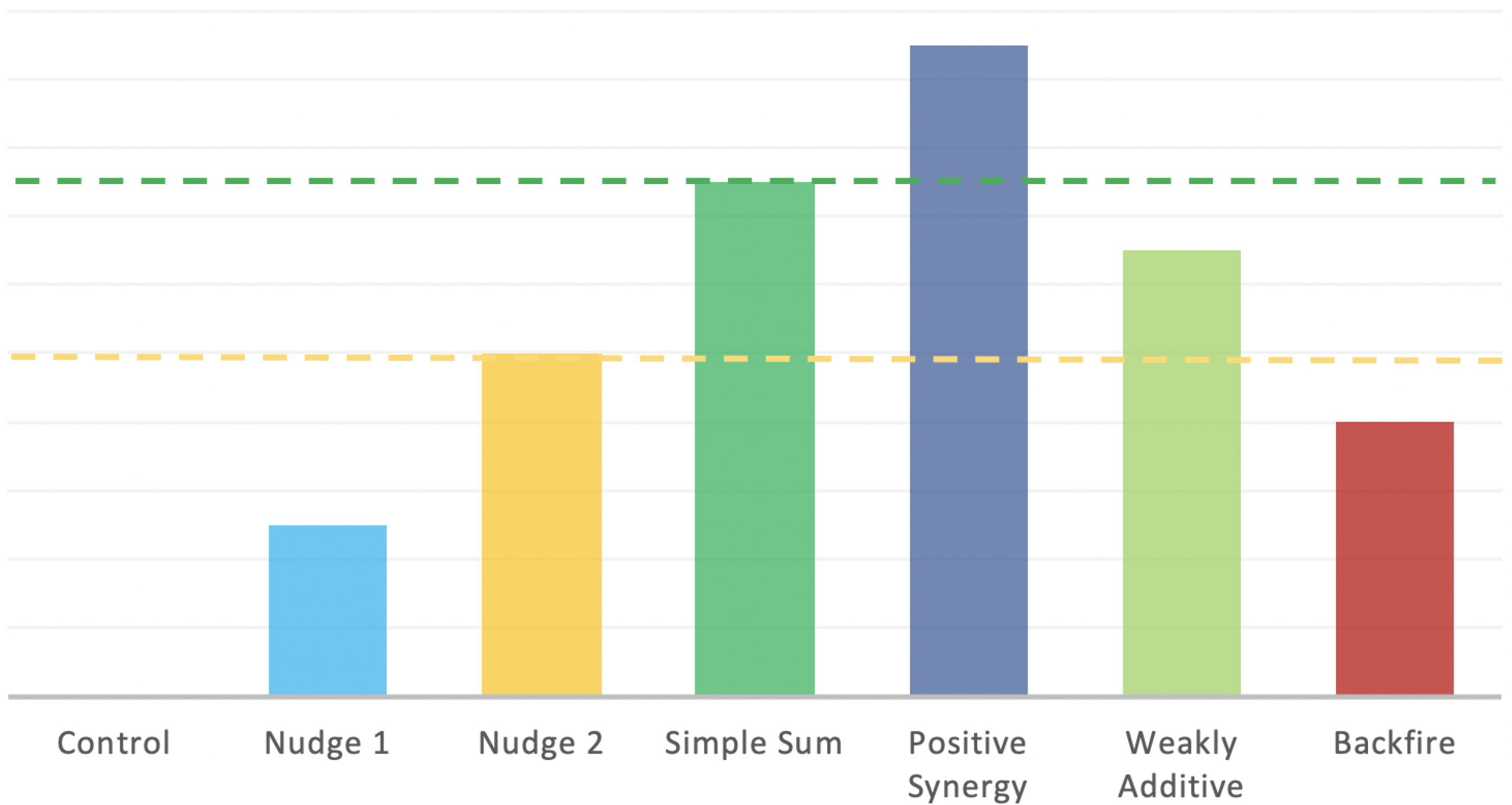
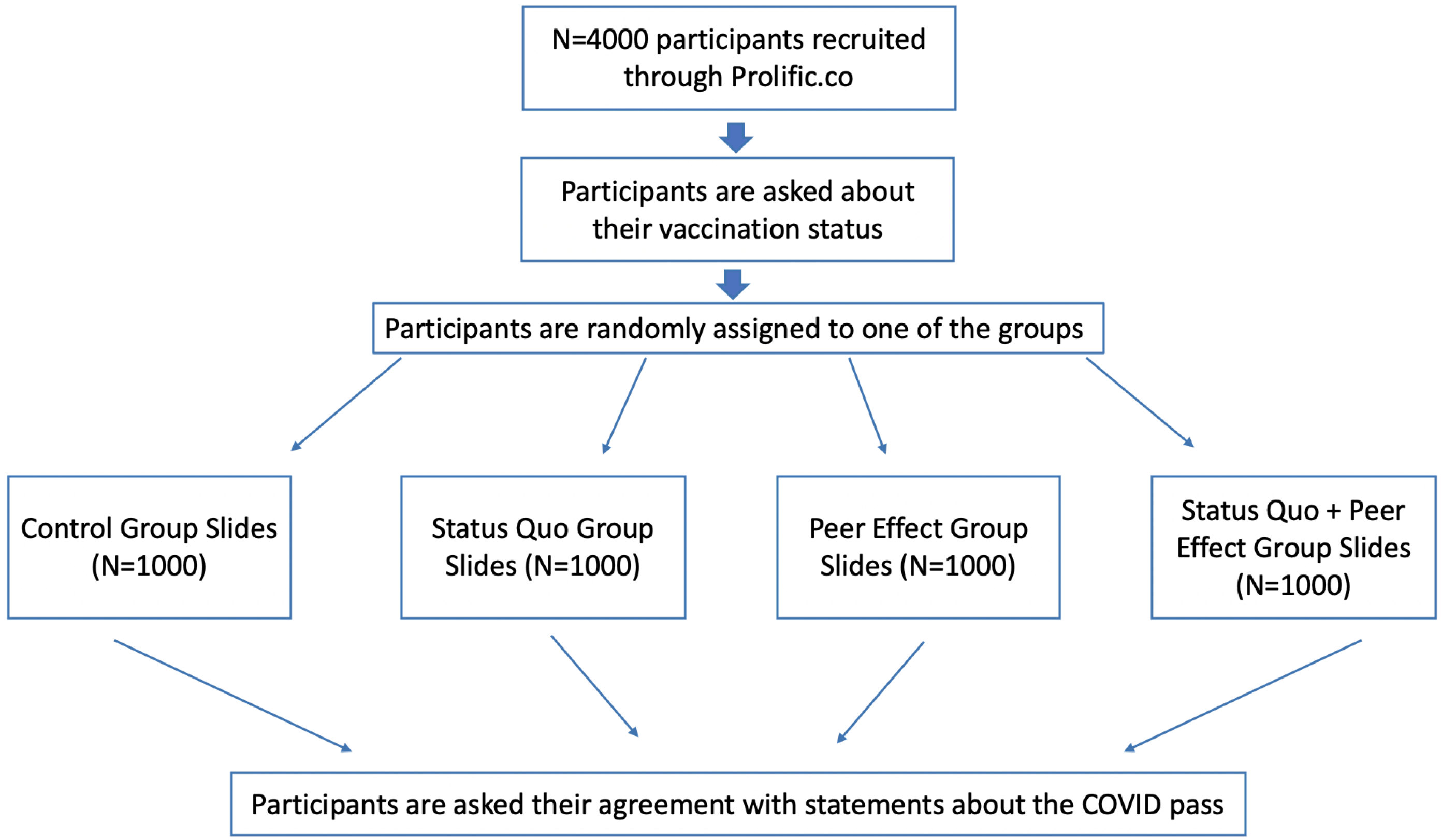
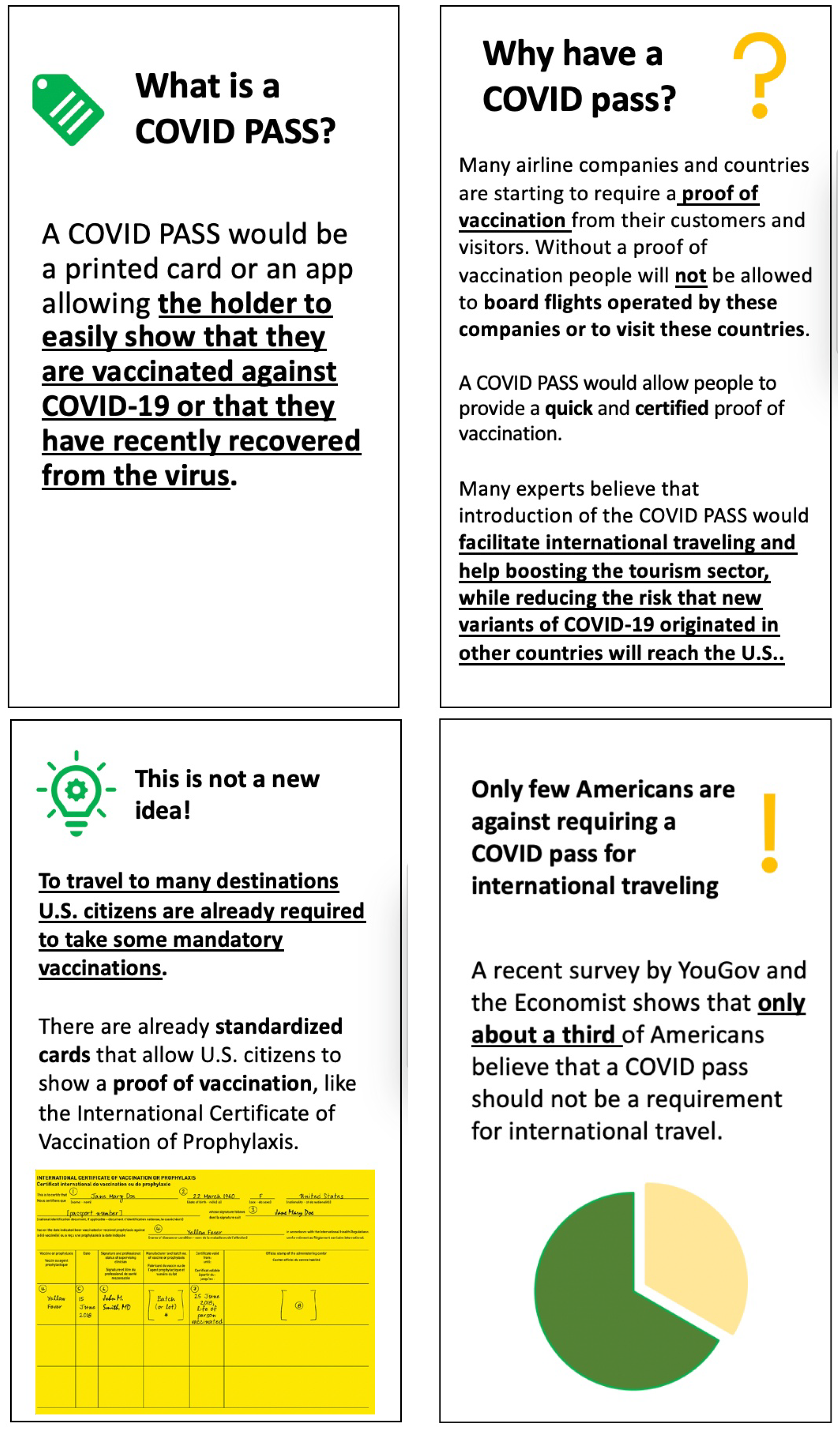
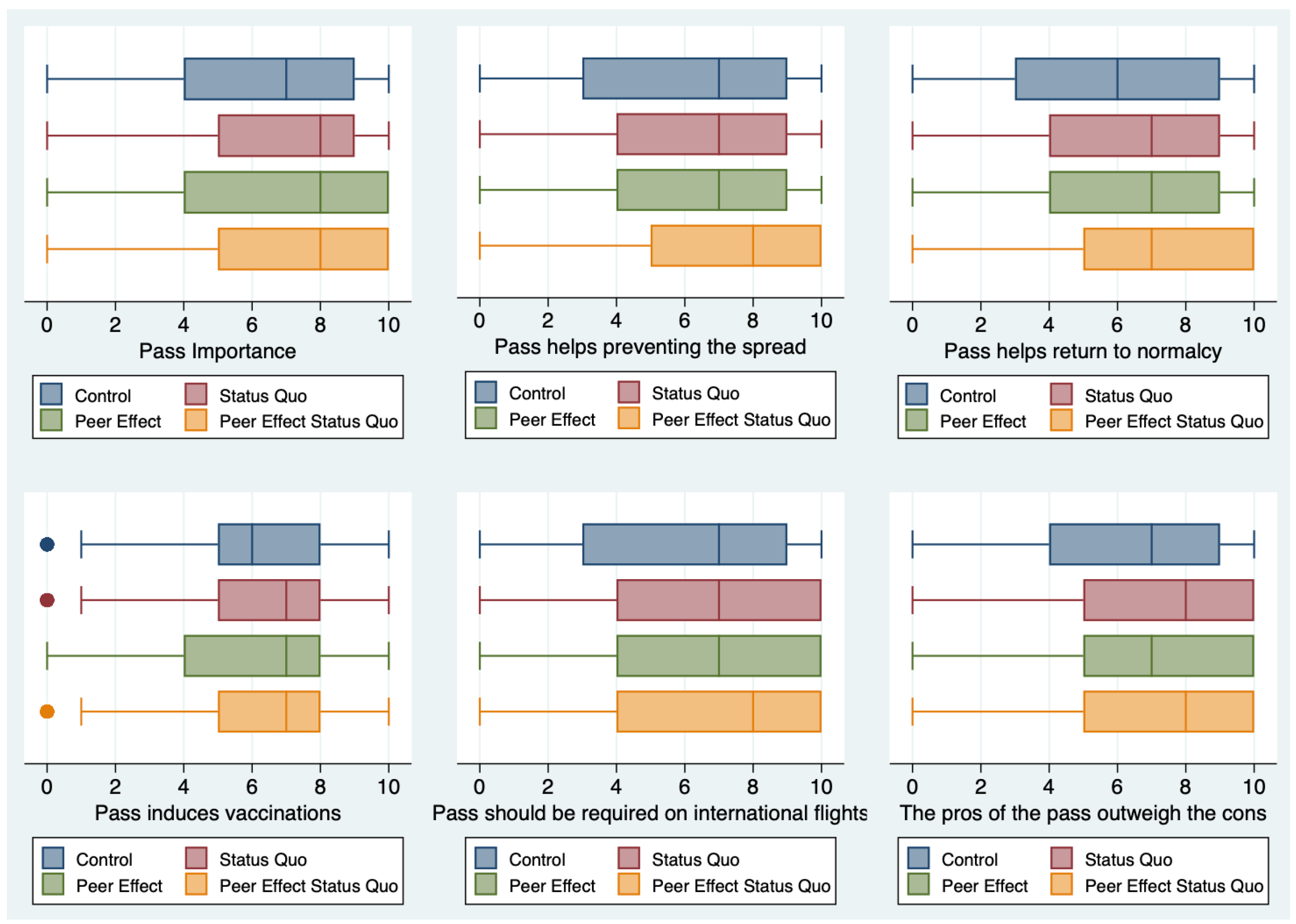
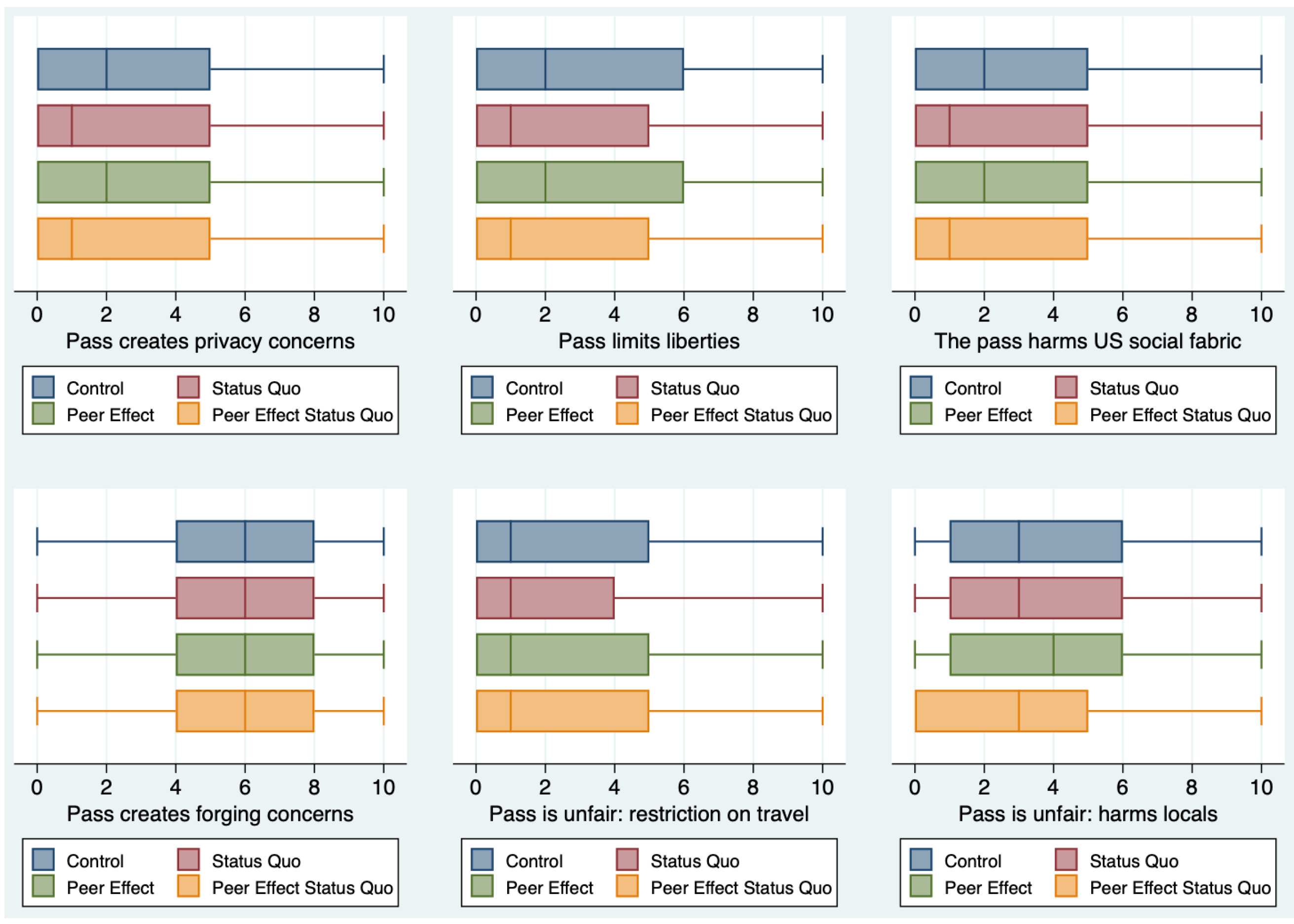
| St. Nr. | Statement | (Total) | (Control) | (Status Quo) | (Peer Effect) | (SQ+ PE) | |||||
|---|---|---|---|---|---|---|---|---|---|---|---|
| Mean | SD | Mean | SD | Mean | SD | Mean | SD | Mean | SD | ||
| 1 | COVID pass is important to fight COVID-19 | 6.54 | 3.35 | 6.14 | 3.33 | 6.62 | 3.30 | 6.59 | 3.42 | 6.80 | 3.32 |
| 2 | A COVID pass can help to prevent new variants of COVID-19 that might render current COVID-19 vaccines ineffective | 6.29 | 3.40 | 5.90 | 3.39 | 6.22 | 3.40 | 6.34 | 3.41 | 6.68 | 3.37 |
| 3 | A COVID pass is key to returning to normal quickly and safely | 6.16 | 3.38 | 5.78 | 3.40 | 6.19 | 3.29 | 6.17 | 3.44 | 6.52 | 3.37 |
| 4 | A COVID pass is an extreme limitation to the individual liberties of Americans | 3.11 | 3.45 | 3.29 | 3.44 | 2.91 | 3.39 | 3.31 | 3.58 | 2.90 | 3.37 |
| 5 | A COVID pass could harm the U.S. social fabric | 2.91 | 3.32 | 3.11 | 3.34 | 2.83 | 3.29 | 3.04 | 3.36 | 2.64 | 3.27 |
| 6 | A COVID pass poses severe dangers to Americans’ data privacy | 3.03 | 3.36 | 3.21 | 3.31 | 2.88 | 3.35 | 3.17 | 3.42 | 2.86 | 3.34 |
| 7 | It is unfair that people with a COVID pass can travel internationally, while individuals without it cannot | 2.72 | 3.38 | 2.73 | 3.39 | 2.51 | 3.25 | 2.95 | 3.49 | 2.70 | 3.38 |
| 8 | Allowing people with a COVID pass to travel to countries with lower access to vaccines and potentially come into contact with unvaccinated locals is unfair | 3.66 | 3.21 | 3.68 | 3.17 | 3.55 | 3.14 | 3.91 | 3.27 | 3.49 | 3.25 |
| 9 | A COVID pass could be easily forged | 5.88 | 2.97 | 5.95 | 3.00 | 5.87 | 2.93 | 5.95 | 2.95 | 5.74 | 2.99 |
| 10 | A COVID pass would induce more people to get vaccinated | 6.17 | 2.81 | 6.10 | 2.76 | 6.19 | 2.79 | 6.11 | 2.92 | 6.29 | 2.75 |
| 11 | Only people with a COVID pass should be allowed to board international flights | 6.30 | 3.52 | 6.10 | 3.52 | 6.31 | 3.48 | 6.35 | 3.55 | 6.46 | 3.54 |
| 12 | If a COVID pass were implemented, I would intentionally infect myself with COVID-19 to obtain it | 0.57 | 1.64 | 0.58 | 1.68 | 0.59 | 1.67 | 0.55 | 1.58 | 0.56 | 1.63 |
| 13 | Overall, the pros of requiring a COVID pass for international traveling outweigh the cons | 6.65 | 3.33 | 6.38 | 3.36 | 6.79 | 3.22 | 6.52 | 3.40 | 6.89 | 3.32 |
| Obs | 3993 | 999 | 1000 | 999 | 995 | ||||||
| Group | |||||||||||||||
|---|---|---|---|---|---|---|---|---|---|---|---|---|---|---|---|
| Control | Status Quo | Peer Effect | PE + Status Quo | Total | |||||||||||
| No. | Col % | Cum % | No. | Col % | Cum % | No. | Col % | Cum % | No. | Col % | Cum % | No. | Col % | Cum % | |
| Political Orientation | |||||||||||||||
| Republican | 167 | 16.7 | 16.7 | 165 | 16.5 | 16.5 | 163 | 16.3 | 16.3 | 163 | 16.4 | 16.4 | 658 | 16.5 | 16.5 |
| Democrat | 571 | 57.2 | 73.9 | 575 | 57.5 | 74.0 | 573 | 57.4 | 73.7 | 550 | 55.3 | 71.7 | 2269 | 56.8 | 73.3 |
| Other or No Strong Preference | 261 | 26.1 | 100.0 | 260 | 26.0 | 100.0 | 263 | 26.3 | 100.0 | 282 | 28.3 | 100.0 | 1066 | 26.7 | 100.0 |
| Total | 999 | 100.0 | 1000 | 100.0 | 999 | 100.0 | 995 | 100.0 | 3993 | 100.0 | |||||
| Gender | |||||||||||||||
| Other/Prefer not to declare | 32 | 3.2 | 3.2 | 20 | 2.0 | 2.0 | 30 | 3.0 | 3.0 | 23 | 2.3 | 2.3 | 105 | 2.6 | 2.6 |
| Female | 551 | 55.2 | 58.4 | 582 | 58.2 | 60.2 | 607 | 60.8 | 63.8 | 553 | 55.6 | 57.9 | 2293 | 57.4 | 60.1 |
| Male | 416 | 41.6 | 100.0 | 398 | 39.8 | 100.0 | 362 | 36.2 | 100.0 | 419 | 42.1 | 100.0 | 1595 | 39.9 | 100.0 |
| Income | |||||||||||||||
| Less than $10,000 | 56 | 5.6 | 5.6 | 53 | 5.3 | 5.3 | 66 | 6.6 | 6.6 | 62 | 6.2 | 6.2 | 237 | 5.9 | 5.9 |
| $10,000 to $19,999 | 63 | 6.3 | 11.9 | 64 | 6.4 | 11.7 | 62 | 6.2 | 12.8 | 87 | 8.8 | 15.0 | 276 | 6.9 | 12.9 |
| $20,000 to $29,999 | 93 | 9.3 | 21.2 | 85 | 8.5 | 20.2 | 104 | 10.4 | 23.3 | 82 | 8.3 | 23.3 | 364 | 9.1 | 22.0 |
| $30,000 to $39,999 | 81 | 8.1 | 29.4 | 99 | 9.9 | 30.1 | 95 | 9.5 | 32.8 | 96 | 9.7 | 32.9 | 371 | 9.3 | 31.3 |
| $40,000 to $49,999 | 106 | 10.6 | 40.0 | 106 | 10.6 | 40.7 | 82 | 8.2 | 41.0 | 71 | 7.2 | 40.1 | 365 | 9.2 | 40.5 |
| $50,000 to $59,999 | 112 | 11.2 | 51.2 | 111 | 11.1 | 51.9 | 93 | 9.3 | 50.4 | 82 | 8.3 | 48.3 | 398 | 10.0 | 50.4 |
| $60,000 to $69,999 | 74 | 7.4 | 58.6 | 76 | 7.6 | 59.5 | 81 | 8.1 | 58.5 | 82 | 8.3 | 56.6 | 313 | 7.9 | 58.3 |
| $70,000 to $79,999 | 85 | 8.5 | 67.1 | 66 | 6.6 | 66.1 | 75 | 7.5 | 66.0 | 90 | 9.1 | 65.7 | 316 | 7.9 | 66.2 |
| $80,000 to $89,999 | 42 | 4.2 | 71.3 | 55 | 5.5 | 71.6 | 46 | 4.6 | 70.6 | 58 | 5.8 | 71.5 | 201 | 5.0 | 71.3 |
| $80,000 to $89,999 | 54 | 5.4 | 76.8 | 57 | 5.7 | 77.3 | 55 | 5.5 | 76.1 | 53 | 5.3 | 76.8 | 219 | 5.5 | 76.7 |
| $90,000 to $99,999 | 155 | 15.5 | 92.3 | 142 | 14.2 | 91.5 | 139 | 13.9 | 90.1 | 151 | 15.2 | 92.0 | 587 | 14.7 | 91.5 |
| $150,000 or more | 77 | 7.7 | 100.0 | 85 | 8.5 | 100.0 | 99 | 9.9 | 100.0 | 79 | 8.0 | 100.0 | 340 | 8.5 | 100.0 |
| Education | |||||||||||||||
| Less than high school degree | 8 | 0.8 | 0.8 | 7 | 0.7 | 0.7 | 14 | 1.4 | 1.4 | 7 | 0.7 | 0.7 | 36 | 0.9 | 0.9 |
| High school graduate (diploma or equivalent) | 103 | 10.3 | 11.1 | 104 | 10.4 | 11.1 | 102 | 10.2 | 11.6 | 109 | 11.0 | 11.7 | 418 | 10.5 | 11.4 |
| Some college but no degree | 206 | 20.6 | 31.7 | 230 | 23.0 | 34.1 | 230 | 23.0 | 34.6 | 227 | 22.8 | 34.5 | 893 | 22.4 | 33.8 |
| Associate degree in college (2-year) | 93 | 9.3 | 41.0 | 84 | 8.4 | 42.5 | 109 | 10.9 | 45.5 | 111 | 11.2 | 45.7 | 397 | 9.9 | 43.7 |
| Bachelor’s degree in college | 400 | 40.0 | 81.1 | 373 | 37.3 | 79.9 | 347 | 34.7 | 80.3 | 371 | 37.3 | 83.0 | 1491 | 37.4 | 81.1 |
| Master’s degree or Professional Degree (JD, MD) | 176 | 17.6 | 98.7 | 177 | 17.7 | 97.6 | 169 | 16.9 | 97.2 | 148 | 14.9 | 97.9 | 670 | 16.8 | 97.8 |
| Doctoral degree | 13 | 1.3 | 100.0 | 24 | 2.4 | 100.0 | 28 | 2.8 | 100.0 | 21 | 2.1 | 100.0 | 86 | 2.2 | 100.0 |
| Age | |||||||||||||||
| 18–25 years old | 253 | 25.3 | 25.3 | 250 | 25.0 | 25.0 | 218 | 21.8 | 21.8 | 240 | 24.1 | 24.1 | 961 | 24.1 | 24.1 |
| 26–35 years old | 343 | 34.3 | 59.7 | 354 | 35.4 | 60.4 | 358 | 35.8 | 57.7 | 317 | 31.9 | 56.0 | 1372 | 34.4 | 58.4 |
| 36–45 years old | 185 | 18.5 | 78.2 | 179 | 17.9 | 78.3 | 189 | 18.9 | 76.6 | 194 | 19.5 | 75.5 | 747 | 18.7 | 77.1 |
| 46–55 years old | 91 | 9.1 | 87.3 | 109 | 10.9 | 89.2 | 101 | 10.1 | 86.7 | 108 | 10.9 | 86.3 | 409 | 10.2 | 87.4 |
| 56–65 years old | 64 | 6.4 | 93.7 | 50 | 5.0 | 94.2 | 61 | 6.1 | 92.8 | 73 | 7.3 | 93.7 | 248 | 6.2 | 93.6 |
| 66–75 years old | 21 | 2.1 | 95.8 | 19 | 1.9 | 96.1 | 24 | 2.4 | 95.2 | 31 | 3.1 | 96.8 | 95 | 2.4 | 96.0 |
| >75 years old | 42 | 4.2 | 100.0 | 39 | 3.9 | 100.0 | 48 | 4.8 | 100.0 | 32 | 3.2 | 100.0 | 161 | 4.0 | 100.0 |
| In full or part time employment | 659 | 66.0 | 100.0 | 642 | 64.2 | 100.0 | 649 | 65.0 | 100.0 | 643 | 64.6 | 100.0 | 2593 | 64.9 | 100.0 |
| Student | 106 | 10.6 | 100.0 | 117 | 11.7 | 100.0 | 127 | 12.7 | 100.0 | 120 | 12.1 | 100.0 | 470 | 11.8 | 100.0 |
| White | 741 | 74.2 | 100.0 | 761 | 76.1 | 100.0 | 730 | 73.1 | 100.0 | 709 | 71.3 | 100.0 | 2941 | 73.7 | 100.0 |
| Nr. Stmt | N | ||||||
|---|---|---|---|---|---|---|---|
| 1 | 3705 | 0.525 | <0.001 | 0.56 | <0.001 | 0.707 | <0.001 |
| 2 | 3704 | 0.404 | 0.002 | 0.544 | <0.001 | 0.88 | <0.001 |
| 3 | 3696 | 0.471 | <0.001 | 0.48 | <0.001 | 0.792 | <0.001 |
| 4 | 3656 | −0.413 | 0.001 | −0.101 | 0.438 | −0.485 | <0.001 |
| 5 | 3639 | −0.308 | 0.014 | −0.195 | 0.128 | −0.527 | <0.001 |
| 6 | 3636 | −0.364 | 0.004 | −0.188 | 0.137 | −0.443 | <0.001 |
| 7 | 3634 | −0.331 | 0.008 | 0.0755 | 0.566 | −0.134 | 0.302 |
| 8 | 3664 | −0.207 | 0.137 | 0.175 | 0.218 | −0.264 | 0.059 |
| 9 | 3703 | −0.09 | 0.488 | −0.0582 | 0.66 | −0.221 | 0.094 |
| 10 | 3701 | 0.107 | 0.362 | 0.0308 | 0.797 | 0.17 | 0.141 |
| 11 | 3693 | 0.305 | 0.024 | 0.302 | 0.027 | 0.361 | 0.008 |
| 12 | 3579 | 0.0314 | 0.681 | −0.0094 | 0.897 | 0.0046 | 0.951 |
| 13 | 3690 | 0.494 | <0.001 | 0.24 | 0.055 | 0.592 | <0.001 |
| Status | N | ||||||
|---|---|---|---|---|---|---|---|
| Unvaccinated | 1158 | 0.0124 | 0.897 | −0.12 | 0.238 | −0.01 | 0.919 |
| One Dose | 433 | −0.275 | 0.059 | −0.0807 | 0.501 | 0.103 | 0.31 |
| Vaccinated | 2121 | −0.03 | 0.494 | 0.007 | 0.879 | −0.026 | 0.572 |
| All Sample | 3716 | −0.0535 | 0.279 | −0.07 | 0.169 | −0.033 | 0.505 |
Publisher’s Note: MDPI stays neutral with regard to jurisdictional claims in published maps and institutional affiliations. |
© 2021 by the authors. Licensee MDPI, Basel, Switzerland. This article is an open access article distributed under the terms and conditions of the Creative Commons Attribution (CC BY) license (https://creativecommons.org/licenses/by/4.0/).
Share and Cite
Sotis, C.; Allena, M.; Reyes, R.; Romano, A. COVID-19 Vaccine Passport and International Traveling: The Combined Effect of Two Nudges on Americans’ Support for the Pass. Int. J. Environ. Res. Public Health 2021, 18, 8800. https://doi.org/10.3390/ijerph18168800
Sotis C, Allena M, Reyes R, Romano A. COVID-19 Vaccine Passport and International Traveling: The Combined Effect of Two Nudges on Americans’ Support for the Pass. International Journal of Environmental Research and Public Health. 2021; 18(16):8800. https://doi.org/10.3390/ijerph18168800
Chicago/Turabian StyleSotis, Chiara, Miriam Allena, Renny Reyes, and Alessandro Romano. 2021. "COVID-19 Vaccine Passport and International Traveling: The Combined Effect of Two Nudges on Americans’ Support for the Pass" International Journal of Environmental Research and Public Health 18, no. 16: 8800. https://doi.org/10.3390/ijerph18168800
APA StyleSotis, C., Allena, M., Reyes, R., & Romano, A. (2021). COVID-19 Vaccine Passport and International Traveling: The Combined Effect of Two Nudges on Americans’ Support for the Pass. International Journal of Environmental Research and Public Health, 18(16), 8800. https://doi.org/10.3390/ijerph18168800






